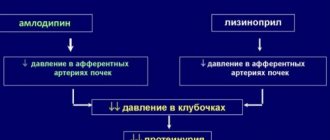Thiazide diuretics in the treatment of arterial hypertension
Chlorothiazide, the first thiazide diuretic effective when taken orally, was created in 1956. In 1957, hydrochlorothiazide (HCT) was synthesized, which replaced chlorothiazide from clinical practice due to its higher effectiveness. In 1959, the thiazide-like diuretic chlorthalidone appeared, and indapamide in 1974. The most frequently used and, therefore, the most studied diuretics in clinical trials are chlorthalidone, HCTZ and indapamide (including indapamide retard form). In our country, the most popular diuretics are HCTZ and indapamide (indapamide retard). However, despite the recognition of the clinical value of this class of drugs, in recent years their leading position has been questioned, and this was primarily due to the discussion of their metabolic effects, with the results of the ACCOMPLISH study [7] and a new meta-analysis of the antihypertensive effects of HCTZ [8]. Metabolic effects of diuretics: myths and reality Negative metabolic effects on carbohydrate, lipid and purine metabolism, and electrolyte disturbances are used as arguments against the priority use of TDs as first-choice drugs. The most significant debate has developed in recent years around the “diabetogenic” effects of TD. A drug is considered a significant factor in the manifestation of diabetes mellitus (DM) if, firstly, the number of patients who developed diabetes mellitus while using this drug is greater than with the natural course of hypertension, and, secondly, the development of diabetes mellitus during therapy is accompanied by a worsening of clinical symptoms. outcomes. Available data allow discussion of differences between the main classes of drugs in relation to the development of new cases of diabetes. However, the significance of the existing evidence to date should be considered limited, primarily due to the fact that in none of the completed large controlled studies, the development of new diabetes was not the primary endpoint. An analysis of 27 randomized controlled trials involving 158,709 patients (of which 33,395 with diabetes), comparing the effect of the “old” and “new” antihypertensive therapy regimens on cardiovascular events and mortality in patients with hypertension depending on the presence of diabetes, did not reveal differences in reducing the risk of major cardiovascular events in patients with or without diabetes during therapy based on ACE inhibitors, AK, ARB II and TD/BB. Tighter BP control was accompanied by a significant reduction in major cardiovascular events in patients with diabetes compared with patients without diabetes [9]. Consequently, all modern classes of antihypertensive drugs, including TDs, can be used in the treatment of hypertension. In the ARIC cohort study (Atherosclerotic Risk in Community cohort, n=13877) - one of the most methodologically high-quality observations - when analyzing the subgroup with hypertension (3804 people), TD therapy compared with untreated patients was not accompanied by an increase in the incidence of diabetes (RR 0.91 , 95% CI 0.73–1.13), which was not significantly different from data for ACE inhibitors (RR 0.98, 95% CI 0.72–1.34) or OCs (RR 1.17, 95% CI 0.83–1.66) [10]. Only BB therapy led to a significant increase in new cases of diabetes (RR 1.28, 95% CI 1.04–1.57; p<0.05). In the EWPHE, STOP-Hypertension-2, INSIGHT, ALLHAT, LIFE, ASCOT-BPLA studies, a higher incidence of diabetes was indeed observed in the groups where TD was prescribed [11–16]. However, EWPHE, STOP-Hypertension-2, INSIGHT and ALLHAT did not reveal any advantages of other drugs over TD in terms of outcomes [12,13,14,16]. The LIFE study [15] found differences in the primary endpoint, and the ASCOT-BPLA study [11] found differences in secondary cardiovascular outcomes, but it should be remembered that in the latter two studies, TDs were not the main drugs. It seems important to note significant methodological differences when identifying new cases of diabetes. For example, in the EWPHE study, the assessment of new cases of diabetes was based on physician reports [12]. In summary, none of the completed studies considered new cases of diabetes as a primary endpoint. Inconsistent results regarding new cases of diabetes may be due to differences in study design and duration, sample sizes, comparison groups, patient populations, laboratory techniques, drugs, and dosages used. Data obtained from comparing two treatment regimens may equally reflect both the positive effect of one drug and the negative effect of the other. Despite the potentially negative effects of TD on glucose metabolism, therapy with this class of drugs leads to a decrease in cardiovascular morbidity and mortality in patients with hypertension. Any possible negative metabolic effects of TD therapy are offset by positive effects on other cardiovascular endpoints and overall mortality. Treatment with relatively high doses of TD during the first year may be accompanied by an increase in the level of total cholesterol and LDL cholesterol by 5–7% without a significant effect on HDL cholesterol; none of the long-term studies revealed an increase in the level of serum cholesterol during TD therapy compared with placebo [17]. The effectiveness of TD in relation to the incidence of strokes, coronary artery disease, and cardiovascular diseases did not depend on the initial cholesterol level in the SHEP study [18]. The adverse effects of TD on lipid metabolism are dose-dependent. At the present stage, HCTZ is used in low doses that are safe from the point of view of its effect on lipid metabolism, and indapamide retard has minimal effect on glucose and lipid metabolism. The effect of long-term TD therapy on cholesterol levels is minimal and may have limited clinical significance. Patients can receive TD regardless of baseline lipid levels, especially given the option of statin therapy. The risk of developing electrolyte disturbances (primarily hypokalemia) is determined by the initial potassium content in the body, the level of salt consumption during treatment, and the doses of diuretics. For a modern dose of HCTZ 12.5–25 mg/day. effects on serum potassium levels are minimal. To prevent hypokalemia induced by diuretics, it is recommended to use minimal doses of diuretics (HCTZ 12.5–25 mg/day, indapamide retard 1.5 mg/day), reducing sodium intake to 2.5 mg/day, increasing intake potassium, the use of diuretics as part of combination therapy. The development of hypokalemia when low doses of diuretics are prescribed is a factor requiring the exclusion of primary hyperaldosteronism [17]. An increase in the level of uric acid in the blood serum, associated with increased reabsorption in the proximal tubules, is also a dose-dependent effect of TD therapy [17]. One of the beneficial metabolic effects of TD that is largely undiscussed is its ability to increase bone density. Treatment with HCTZ is accompanied by an increase in calcium resorption by the renal tubules, a decrease in the activity of total and bone-specific alkaline phosphatase, and a beneficial effect on markers of bone formation (N-telopeptide and osteocalcin). Several RCTs have assessed whether HCTZ improves bone density and have explored possible mechanisms that might explain these effects [19–22]. For example, a randomized, double-blind, two-year study compared HCTZ 50 mg/day. versus placebo in 138 healthy postmenopausal women [19]. Significant effects were found in the active therapy group on the total bone density of the lower leg and forearm, with no effect on the spine or femoral neck. TDs were able to prevent fractures, which is especially important in elderly patients with osteoporosis (not a separate indication, but is considered as an additional positive metabolic effect). According to a cohort study of 7891 patients over 55 years of age (mean age 68.9 years), TD therapy for one year was associated with a statistically significant reduction in the risk of hip fractures (RR 0.46, 95% CI 0.21–0.96) according to compared with persons not receiving diuretic treatment. However, 4 months after cessation of TD therapy, the risk of fractures was similar to that before treatment [21]. Thus, adverse metabolic effects are minimal when diuretics are used in low doses and do not lead to undesirable clinical consequences, and the ability of TD to influence bone density and reduce the risk of osteoporosis deserves attention in a number of clinical situations. Have the results of the ACCOMPLISH trial changed the place of diuretics in the treatment of hypertension? The main result of the ACCOMPLISH study (Avoiding Cardiovascular Events in Combination therapy in Patients Living with Systolic Hypertension) [7] was a significant 20% reduction in the relative risk of cardiovascular morbidity and mortality (primary combined endpoint) in the group of patients with high-risk hypertension (n= 11506) receiving benazepril/amlodipine compared with those receiving benazepril/hydrochlorothiazide at 36 months. observations. To date, this is the only study to compare outcomes between two fixed combinations of antihypertensive drugs. Anticipating the main question in connection with the ACCOMPLISH results, whether the combination of an ACEI with a calcium antagonist should replace the combination of an ACEI with a thiazide diuretic, the authors emphasized that “the results of the study should not cast doubt on the ability of diuretics to reduce the risk of cardiovascular events in patients with hypertension” [7]. . To explain the results obtained, the characteristics of the observation group, the characteristics of the end point, the choice of diuretic, and the dose of amlodipine and hydrochlorothiazide were discussed. The observation group turned out to be a population with indications for the prescription of a calcium antagonist and relative contraindications for the prescription of a thiazide diuretic [3–5]: the average age of the patients was 68 years, 60% of them had a history of diabetes mellitus, 50% had obesity, 36% had coronary revascularization , 23% – myocardial infarction, 11% – history of unstable angina (patients with asymptomatic systolic dysfunction were not included). Thus, the ACCOMPLISH population was not representative and, therefore, its results cannot be extrapolated to all patients with hypertension. In addition, the tolerability of therapy with a combination that included HCTZ was better than that with a combination using amlodipine. The primary composite endpoint did not include hospitalization for heart failure (an event for which calcium antagonists are known to be inferior to other drugs, including thiazide diuretics)23,24, but did include coronary revascularization (usually a component of the secondary endpoint). . Moreover, revascularization accounted for more than 40% of events recorded as the primary endpoint. Thus, a number of features of the observation population and primary endpoint largely explain the differences observed. Another reason discussed was the choice of diuretic, with the assumption that HCTZ is less effective than chlorthalidone in reducing the risk of cardiovascular events. Hydrochlorothiazide and chlorthalidone differ in their pharmacokinetic characteristics. HCTZ begins to act 2 hours after administration, the peak of its effect occurs after 4–6 hours. With a single dose, the duration of action is about 12 hours. With long-term use, the duration of the antihypertensive effect increases and reaches 24 hours. Knowledge of the pharmacokinetics of HCTZ can protect you from a common mistake – premature change of treatment tactics. Unlike HCTZ, the peak effect of chlorthalidone occurs after 6 hours. Moreover, the drug has a very long half-life - about 42 hours. This is due to the fact that chlorthalidone accumulates in red blood cells and is slowly released from them into the plasma, providing a long-lasting therapeutic effect. The fact that the pharmacokinetic characteristics of HCTZ did not affect blood pressure control in the ACCOMPLISH study is evidenced by the results of a substudy using ABPM, which confirmed the comparability of blood pressure control [25]. A meta-analysis specifically comparing the results of studies using chlorthaladione or other TDs, including HCTZ (5 studies, 2 of which used chlorthalidone), did not reveal significant differences in the effect of chlorthaladione and other TDs on clinical outcomes [26]. . Therefore, there is currently no strong evidence to support the use of chlorthalidone instead of HCTZ. Available evidence suggests that one of these two drugs should be used to treat hypertension. The question of the advantages of one drug over another can only be resolved in a study with a direct comparison of them. The effectiveness of HCTZ was also criticized by a meta-analysis of studies that compared the antihypertensive effects of HCTZ with other drugs, with the conclusion that HCTZ is a “weak drug”, which is effective in modern doses of 12.5–25 mg/day. “has not been proven in any randomized controlled trial” and that it “should be excluded from first-line antihypertensive treatment” [8]. It should be noted that this meta-analysis included studies in which HCTZ in daily doses of 12.5 and 25 mg was used as monotherapy. Meta-analysis, as a methodological approach, has a number of known limitations, and in terms of its evidentiary power it is significantly inferior to double-blind randomized studies. A double-blind, randomized trial of indapamide retard, amlodipine, or hydrochlorothiazide (Hypothiazide) in elderly patients showed similar efficacy of the treatment regimens [27] (Fig. 1). From the point of view of modern recommendations on hypertension, it is obvious that it is not relevant to consider diuretic monotherapy as a strategy of preferential choice. The common position of all modern recommendations on hypertension is the emphasis on combination antihypertensive therapy, and from this point of view, the fact that HCTZ increases the effectiveness of all classes of antihypertensive drugs without exception when used in a combination regimen is very important. In addition, almost all representatives of the classes of ACE inhibitors, ARA II and some b-blockers are in the form of fixed combinations containing HCTZ at a dose of 12.5–25 mg. Moreover, it is HCTZ that is part of the first registered fixed three-component combination of APAII, AK and TD. All this puts HCT in the position of the most widely used TD throughout the world. The effectiveness of HCTZ as initial or adjunctive therapy on outcome has been well established in randomized controlled trials (Table 1). Use of the drug in low doses was associated with improved outcomes in a number of early and modern studies in the field of hypertension. Thus, in the placebo-controlled study EWPHE (European Working Party on High blood pressure in the Elderly trial) in patients over 60 years of age (average age 72 years) in the HCTZ therapy group 25 mg/day. and triamterene 50 mg/day. There was a significant decrease in cardiovascular mortality, mortality from myocardial infarction, and the number of non-fatal cerebrovascular complications [12]. According to the comparative study MRC Substudy (Medical Research Council trial of treatment hypertension in older adults), in the group of patients receiving diuretics (amiloride 2.5 mg/day + HCTZ 25 mg/day), the risk of developing strokes, cardiac events and all cardiovascular complications compared with the placebo group. In the atenolol group 50 mg/day. no significant reduction in the frequency of the above events was detected [28]. In the ANBP-2 study (Second Australian National Blood Pressure Study) in 6083 elderly patients with equally significant reductions in blood pressure, mixed results were obtained regarding the benefits of ACEIs over HCTZ. ACE inhibitors were more effective in preventing a combination of cardiovascular events (RR 0.89, 95% CI 0.79–1.00; p=0.05). Moreover, in the ACEI group, the risk of fatal stroke was almost twice as high as in the diuretic group (OR 1.91, 95% CI 1.04–3.5, p=0.01) [29]. Analysis of the results of the LIFE study, during which, of 9193 hypertensive patients with ECG-LVH, 70% received HCTZ in addition to the main therapy with losartan or atenolol during 4.8 years of follow-up [30], specifically addressed the question of how HCTZ administration affected outcomes. The results of the analysis showed that additional administration of HCTZ 12.5–25 mg/day. was associated with lower cardiovascular morbidity, cardiovascular and overall mortality, regardless of blood pressure reduction, regression of LVH and randomized therapy. In patients who received a diuretic, compared with those who did not receive it, the RR for the combined endpoint was 0.70 (0.62–0.80), cardiovascular death 0.58 (0.47–0.71), myocardial infarction 0 .64 (0.51–0.79), stroke 0.82 (0.68–0.99), death from any cause 0.55 (0.47–0.64). Thus, data from randomized controlled trials convincingly demonstrate the ability of HCTZ at a dosage of 12.5–25 mg/day. improve clinical outcomes in hypertension and the value of this drug in its treatment. The conclusion of thiazide diuretics still remain the cornerstone of modern antihypertension therapy and are an affordable effective class of antihypertensive drugs. This is one of the classes of antihypertensive drugs, which fully retained its value in the treatment of hypertension from the moment of its creation. Adverse metabolic effects are minimally expressed when using thiazide diuretics in low doses and do not lead to undesirable clinical consequences. Hydrochlorotiazide is one of the most studied diuretics, included in most fixed combinations of antihypertensive drugs and currently remains one of the most important drugs to reduce blood pressure, reliably reducing the risk of developing cardiovascular complications and reducing mortality from cardiovascular diseases.
References 1. Chobanian AV, Bakris GL, Black HR et al. Seventh report of the Joint National Committee on prevention, detection, evaluation and treatment of high blood pressure. Hypertension. 2003;42:1206–1252. 2. 2003 World Health Organization (WHO)/International Society of Hypertension (ISH) statement on management of hypertension. J Hypertens 2003;21:1983–1992. 3. 2007 Guidelines for the Management of Arterial Hypertension: The Task Force for the Management of Arterial Hypertension of the European Society of Hypertension (ESH) and of the European Society of Cardiology (ESC); Journal of Hypertension. 25(6):1105–1187, June 2007. 4. Diagnosis and treatment of arterial hypertension, Recommendations of the Russian Medical Society on Arterial Hypertension and the All-Russian Scientific Society of Cardiologists, Appendix 2 to the journal “Cardiovascular Therapy and Prevention” 2008; 7(6) 5. Mancia G, Laurent S, Agabiti–Rosei E et al. Reappraisal of European guidelines on hypertension management: a European Society of Hypertension Task Force document. J Hypertens 2009, 27:2121–2158 6. Williams B, Poulter NR, Brown MJ et al. British Hypertension Society guidelines for hypertension management 2004 (BHS–IV): summary. BMJ 2004;328:634–64 7. Jamerson K, Weber MA, Bakris GL, et al. Benazepril plus amlodipine or hydrochlorothiazide for hypertension in high-risk patients. N Engl J Med 2008;359:2417–28 8. Messerli FH et al. Hydrochlorothiazide is inappropriate for first–line antihypertensive therapy. ESH Meeting; June 12–16, 2009; Milan, Italy. Abstract LB1.3. 9. Blood Pressure Lowering Treatment Trialists' Collaboration. Effects of different blood pressure–lowering regimens on major cardiovascular events in individuals with and without diabetes mellitus designed: results of prospectively overviews of randomized trials. Arch Intern Med. 2005;165:1410–9. 10. Gress TW, Nieto FJ, Shahar E. et al. Hypertension and antihypertensive therapy as risk factors for type 2 diabetes mellitus. N Engl J Med 2000;342:905–912 11. Dahlof B, Sever PS, Poulter NR, et al. Prevention of cardiovascular events with an antihypertensive regimen of amlodipine adding perindopril as required versus atenolol adding bendroflumethiazide as required, in the Anglo–Scandinavian Cardiac Outcomes Trial–Blood Pressure Lowering Arm (ASCOT–BPLA): a multicentre randomized controlled trial. Lancet 2005;366:895–906. 12. Fletcher A., Amery A., Birkenhager W. et al. Risks and benefits in the trial of the European Working Party on High Blood Pressure in the Elderly. J Hipertens 1991;9:225–2230 13. Hansson L, Lindholm LH, Ekbom T et al. Randomized trial of old and new antihypertensive drugs in elderly patients: cardiovascular mortality and morbidity the Swedish Trial in Old Patients with Hypertension–2 study. Lancet 1999;354:1751–1756. 14. Mancia G., Broun M., Castaigne A. et al. Outcomes with nifedipine GITS or co-amilozide in hypertensive diabetics and nondiabetics in Intervention as a Goal in Hypertension (INSIGHT). Hypertension 2003;41:431–436. 15. Dahlof B, Devereux RB, Kjeidsen SE et al. Cardiovascular morbidity and mortality in the Losartan Intervention For Endpoint reduction in hypertension study (LIFE): a randomized trial against atenolol. Lancet. 2002;359:995–1003. 16. ALLHAT Officers and Coordinators for the ALLHAT Collaborative Research Group. Major outcomes in high–risk hypertensive patients randomized to angiotensin–converting enzyme inhibitor or calcium channel blockers diuretic: The Antihypertensive and Lipid–Lowering Treatment to Prevent Heart Attack Trial (ALLHAT). JAMA 2002;288:2981–2997. 17. Michael E. Ernst, Pharm.D., and Marvin Moser, MD Use of Diuretics in Patients with Hypertension N Engl J Med 2009;361:2153–64. 18. Savage PH, Pressel SL, Curb D. et al. Influence of long–term, low–dose, diuretic–based anyhypertensive therapy on glucose, lipid, uric acid, and potassium levels in older men and women with isolated systolic hypertension. Arch Intern Med 1998;158:741–751. 19. Raid IR, Ames RW, Orr–Walker BJ et al. Hydrochlorothiazide reduces loss of cortical bone in normal postmenopausal women: a randomized controlled trial. Am J Med. 2000;109:362–370. 20. LaCroix AZ, Ott SM, Ichikawa L. et al. Low–Dose Hydrochlorothiazide and Preservation of Bone Mineral Density in Older Adults: A Randomized, Double–Blind, Placebo–Controlled Trial. Ann Intern Med. 2000;133:516 – 526. 21. Schoofs M, Klift M, Hofman A et al. Thiazide diuretics and the risk for hip fracture. Ann Intern Med. 2003;139:476–482. 22. Raid IR, Ames RW, Orr–Walker BJ et al. Hydrochlorothiazide reduces loss of cortical bone in normal postmenopausal women: a randomized controlled trial. Am J Med. 2000;109:362–370. 23. Psaty BM, Lumley T, Furberg CD, et al. Health outcomes associated with various antihypertensive therapies used as first–line agents: a network meta–analysis. JAMA 2003;289:2534–44. 24. Costanzo P, Perrone–Filardi P, Petretta M et al. Calcium channel blockers and cardiovascular outcomes: a meta-analysis of 175,634 patients. J Hypertens 2009; 27:1136–1151 25. https://www.medscape.com/viewarticle/702679 26. Barry L. Carter, Michael E. Ernst and Jerome D. Cohen Hydrochlorothiazide Versus Chlorthalidone: Evidence Supporting Their Interchangeability Hypertension 2004; 43;4–9 27. Emeriau JP, Knauf H, Pujadas JO et al. A comparison of indapamide SR 1.5 mg with both amlodipine 5 mg and hydrochlorothiazide 25 mg in elderly hypertensive patients: a randomized double–blind controlled study. J Hypertens 2001; 19;343–350 28. Medical research council working party. Medical research council trial to treatment of hypertension in older adults: principal results. BMJ 1992;304:405–12. 29. Wing LM, Reid CM, Ryan P. et al. Second Australian National Blood Pressure Study Group. A comparison of outcomes with angiotensin–converting–enzyme inhibitors and diuretics for hypertension in the elderly. N Engl J Med 2003;348:583–592. 30. Okin PM, Devereux RB; Hille DA et al. Concomitant Hydrochlorothiazide Therapy in Hypertensive Patients is Associated with Reduced Cardiovascular Morbidity and Mortality.
Medicinal and herbal diuretics.
Thursday, September 23
5171
4.7
1
Content
- How to choose a diuretic
- What are the types of diuretics?
- Classes of diuretics and indications for their use
- The best diuretics
- Hydrochlorothiazide
- Furosemide
- Indapamide
- Veroshpiron
- Torasemide
- Triampur compositum
- Diuver
- Dog-rose fruit
- Diuretic collection
- Juniper fruits
The doctor prescribes diuretics for various edema, hypertension, for the prevention of kidney stones, etc. It is no secret that some women even try to lose weight with the help of diuretics, but this is dangerous to health. The fact is that diuretics, together with liquid, remove potassium from the body - muscle contraction (including the heart muscle) is disrupted. That is why such drugs should be prescribed exclusively by a doctor, taking into account the underlying disease, possible contraindications and side effects.
Read also How to treat dehydration: 5 solutions for rehydration What drugs for dehydration are most often prescribed by doctors?
What are the types of diuretics?
All diuretic drugs are divided into several categories: according to their spectrum of use and mechanism of action.
- Loop diuretics.
These drugs have the strongest effect (they begin to act literally a few minutes after administration), but the effect ends just as quickly. Such drugs are well suited for the treatment of hypertension and heart failure. But loop diuretics have a significant disadvantage - along with water, they remove potassium from the body, which is fraught with the development of arrhythmia. - Thiazide diuretics.
Another effective diuretic drug. They not only get rid of excess fluid, but also dilate peripheral vessels. Thiazide diuretics also reduce the response of blood vessels to adrenaline, so they spasm less. Such diuretics are also prescribed for the treatment of urolithiasis. Among the “side effects” are the excretion of potassium and an increase in uric acid, which can then accumulate in the joints and cause gout. - Potassium-sparing diuretics.
Such diuretics do not remove potassium from the body, protecting the patient from various heart complications. But these drugs are not as potent as the previous ones. - Osmotic diuretics.
This group of drugs reduces blood plasma pressure - excess water is quickly removed from the tissues, swelling goes away. The pressure in the tissues and in the plasma becomes the same. Typically, osmotic diuretics are prescribed to relieve swelling of the brain, lungs, and high intraocular or intracranial pressure.
How to choose a diuretic
There are specific factors to consider if you choose a diuretic.
- Speed of action.
There are diuretics for emergency use: if you need to quickly lower high blood pressure (used in combination with other drugs), remove morning puffiness under the eyes. You should not take such medications often because they are addictive. Long-acting diuretics are prescribed to treat hypertension and edema associated with poor heart and liver function. - Pregnancy and breastfeeding.
Any diuretic medications are prohibited for pregnant and lactating women. And only in cases where a pregnant or lactating woman has a threat to her health and life, is it possible to use them. Usually this phrase sounds like “the benefit to the mother outweighs the risk to the fetus.” The exception is practically harmless herbal diuretics, but a woman should talk to her doctor before using them. - Tendency to allergies.
People with allergies may experience an undesirable reaction to both the active ingredient of the diuretic drug and its minor components. If you are allergic, consult your doctor before treatment.
In addition to diuretic medications, mild herbal remedies are often used. They are usually prescribed in the complex treatment of cystitis, urethritis, etc. Herbal diuretics not only remove excess water, but also relieve inflammation.
Drinking diuretics for weight loss is dangerous - the heart muscle suffers
Photos from open sources






